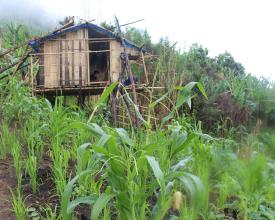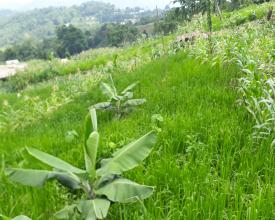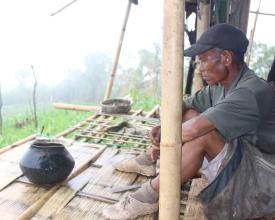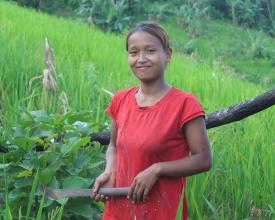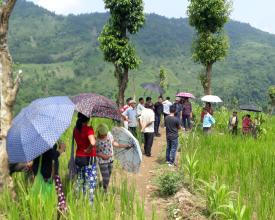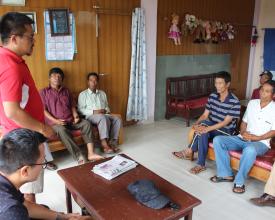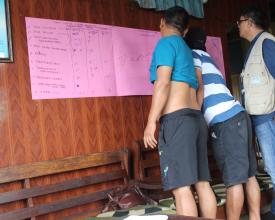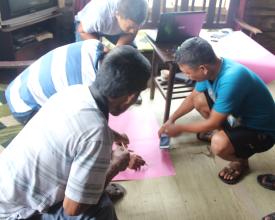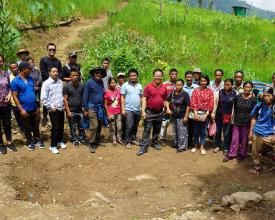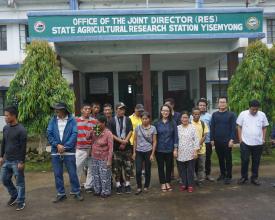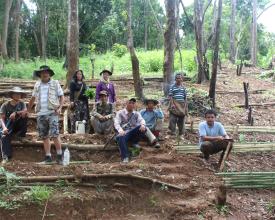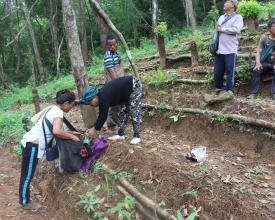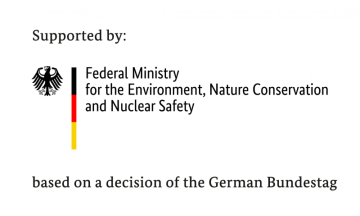Sensibilizar y capacitar a los usuarios de la tierra sobre las medidas de intensificación y optimización del jum en Mizoram (India).

El jhum es una práctica agrícola que se da sobre todo en el noreste de la India y constituye un modo de vida profundamente arraigado en la tradición y la cultura de las comunidades locales de la región.Sin embargo, en el pasado reciente, debido a los cambios en las condiciones socioeconómicas y en los patrones de uso de la tierra, han empezado a surgir deficiencias en los campos de jhum de Mizoram, como la reducción de los ciclos de jhum, la disminución del periodo de barbecho, la pérdida de fertilidad del suelo y el bajo rendimiento de las cosechas, amenazando así la degeneración de los ricos recursos naturales del estado y el bienestar de la comunidad que depende directamente de ellos.
El proyecto IKI-Biodiv ha ayudado a concienciar y a reforzar la capacidad de los usuarios de la tierra sobre las medidas de optimización e intensificación del jhum, lo que contribuirá a promover la biodiversidad y los servicios ecosistémicos, garantizando al mismo tiempo la seguridad alimentaria y los medios de subsistencia de los agricultores.
Contexto
Défis à relever
- El jhumming o la agrosilvicultura rotativa es la principal práctica de uso de la tierra y la mayor fuente de seguridad alimentaria y medios de subsistencia para las comunidades rurales de Mizoram desde hace siglos. Esta práctica está bien adaptada a esta región, crea paisajes culturales y preserva la biodiversidad y los bosques a largo plazo.
- En los últimos años, el jhum se ha visto sometido a tensiones debido a los cambios en el uso de la tierra, el acortamiento del ciclo del jhum, la reducción del periodo de barbecho, la pérdida de fertilidad del suelo y la disminución del rendimiento de las cosechas.
- Por lo tanto, para popularizar la práctica de la optimización y la intensificación del jhum mediante la introducción de medidas para aumentar el período de cultivo, es decir, la gestión del barbecho para restaurar la fertilidad del suelo, la recarga de la humedad del suelo y las aguas subterráneas, la creación de bosques secundarios y otros ingresos subsidiarios, así como la mejora de las actividades microbianas y el mantenimiento de los ecosistemas.
Ubicación
Procesar
Resumen del proceso
- El primer elemento contribuyó a subsanar la falta de conocimientos de las comunidades locales y los usuarios de la tierra, al concienciarles sobre la importancia de la conservación de la biodiversidad y su relación con sus medios de vida y su seguridad alimentaria.
- El segundo elemento les hizo darse cuenta de que las medidas de optimización del jhum no son más que una especie de improvisación del método que ya estaban practicando y, al observar cómo lo practicaban sus homólogos de Nagaland, les ayudó a mejorar sus conocimientos, su capacidad de adaptación y su capacidad de adaptación.
- a mejorar sus conocimientos,
- ganar confianza
- y a ponerlos en práctica en sus aldeas. - Tras la mejora de su capacidad, el tercer bloque de construcción puede abordar eficazmente el desafío, ya que la comunidad local depende del bosque y sus recursos para su subsistencia y la necesidad de conservarlo mediante la adopción de diversas prácticas innovadoras de buen jhuming.
- Por último, la solución proporcionará una oportunidad para convencer al gobierno de que integre las medidas de optimización de la jhum y las incorpore a su política.
Bloques de construcción
Sensibilización mediante formación y talleres
Con el fin de crear conciencia sobre las medidas de optimización jhum ya practicadas por los agricultores de Nagaland, se organizó un taller de 2 días en la aldea del proyecto para los líderes de la comunidad, los agricultores y los funcionarios de campo del departamento forestal. A pesar de que el jhum ha sido practicado por generaciones por los aldeanos, no eran conscientes de las medidas para la intensificación del jhum y su optimización. A través de un proceso participativo y una presentación en power point, se explicaron los beneficios de estas medidas para aumentar sus ingresos agrícolas y mejorar la biodiversidad y los servicios ecosistémicos. Involucrar a los líderes y ancianos de la comunidad, junto con las mujeres y los jóvenes líderes en el programa de formación fue una ventaja añadida, ya que esto aprovechó la urgencia del programa y su aplicación.
Factores facilitadores
- La orientación de las medidas de optimización de las jum a la agencia estatal nodal, es decir, el consejo estatal de biodiversidad y los miembros del consejo del pueblo, fue clave para ganarse la confianza de las partes interesadas.
- La comprensión de los agricultores y las partes interesadas sobre la urgencia del problema y la voluntad de participar activamente y adquirir conocimientos y ponerlos en práctica en su propio jhum.
- La selección del beneficiario que tiene una parcela en el campo jhum actual fue una ventaja añadida.
Lección aprendida
- Incentivar cualquier programa en la aldea en forma de aportaciones/visita de exposición podría generar interés entre la comunidad para participar activamente.
- La planificación participativa del programa en el pueblo junto con los participantes generó más interés y debates.
Mejorar los conocimientos mediante una visita de exposición
Se organizó una visita de una semana a Nagaland del 15 al 20 de julio de 2019 para los agricultores y los líderes de la comunidad de la aldea. Durante la visita se les llevó a los campos de jum y se mostraron las medidas de optimización de jhum adoptadas por los agricultores de Naga. También se organizaron interacciones entre agricultores, en las que los agricultores tuvieron la oportunidad de aclarar sus dudas. También se les llevó a la Estación Estatal de Investigación Agrícola (SARS, por sus siglas en inglés), donde se están llevando a cabo investigaciones sobre medidas de optimización del jum, y la interacción con los científicos les proporcionó nuevos conocimientos.
La visita a Nagaland les ayudó a comprender la metodología y los beneficios de las prácticas mejoradas en su jum.
Factores facilitadores
- Nagaland ha estado adoptando medidas de optimización del cultivo de jum mediante las cuales se han observado excelentes resultados en el aumento de la intensidad de cultivo en el campo de jum.
- Se preparó un itinerario bien planificado y se organizó la logística del viaje con suficiente antelación, y el momento de la visita coincidió con la temporada activa de jum.
- Se contactó con las autoridades gubernamentales de Nagaland antes del viaje para explicarles el propósito y los detalles de la visita.
- La selección de los agricultores para la visita se hizo teniendo en cuenta la participación de los líderes de la comunidad, las mujeres y los jóvenes.
Lección aprendida
La visita de exposición generó entusiasmo entre los agricultores y aumentó su confianza. El momento de la visita fue perfecto, ya que se pudieron observar todas las operaciones de optimización del jhum sobre el terreno. Esta visita brindó la oportunidad de intercambiar germoplasma de cultivos entre los agricultores y creó una vía para mejorar la conservación de la biodiversidad.
La lección aprendida más importante fue que la visita de exposición, además de aumentar los conocimientos, actúa como un medio para crear confianza y vínculos entre las tribus de las colinas que practican un uso de la tierra y un modelo de cultivo similares en la región.
Medidas de demostración para la optimización de Jhum
La demostración de las medidas de optimización de los campos de jum en los campos de los agricultores sobre una base piloto con la participación de la comunidad mostrará resultados que convencerán a los agricultores de cómo una pequeña modificación en el sistema actual de gestión de los campos de jum marcará la diferencia en términos de conservación del suelo, aumento del nivel de fertilidad y mejora de la humedad del suelo, al tiempo que aumenta el rendimiento de los cultivos y mejora los servicios del ecosistema.
Factores facilitadores
La construcción de la confianza de los usuarios de la tierra y la comunidad, así como las lecciones aprendidas durante la visita de exposición a Nagaland, fue una ventaja añadida, ya que pudieron ver por sí mismos la diferencia de practicar jhum mejorado.
Las comunidades ya practicaban el sistema de cultivo jhum y adoptar algunas modificaciones en la gestión no les supuso ningún problema.
Lección aprendida
La interacción regular y los debates centrados en la comunidad y los usuarios de la tierra son un componente clave para cualquier programa basado en la comunidad. La creación de confianza con el consejo del pueblo y los líderes de la comunidad es importante, dado que la tierra y el bosque están gobernados por ellos y sus decisiones son importantes para el buen funcionamiento de las actividades en el pueblo.
El momento de aplicación de este elemento es muy importante, ya que debe comenzar con la selección de la parcela jhum. En este caso ya había cultivos en el campo jhum y no podían ser perturbados. Por lo tanto, para la demostración se seleccionó una parcela de 100 metros cuadrados cerca del campo de jhum donde se llevaron a cabo las medidas.
Recursos
Impactos
- Se concienció a funcionarios, líderes comunitarios y agricultores sobre la conservación de la biodiversidad y la gestión de los ecosistemas.
- Se despertó el interés de los agricultores y los líderes de la comunidad por adoptar diferentes medidas de optimización en sus campos de jum.
- Los agricultores empezaron a conservar las plántulas de árboles forestales y los retoños de los árboles durante la escarda en sus campos de jum.
- El departamento de medio ambiente forestal y vida silvestre mostró su interés y se mostró dispuesto a evaluar a los aldeanos con plantones de árboles listos para plantar.
Beneficiarios
Los miembros del consejo de la aldea y los agricultores del pueblo de Khawrihnim, en Mizoram, fueron los principales beneficiarios. Además, un grupo de autoayuda y funcionarios del departamento forestal también se beneficiaron del programa.
Objetivos de Desarrollo Sostenible
Historia
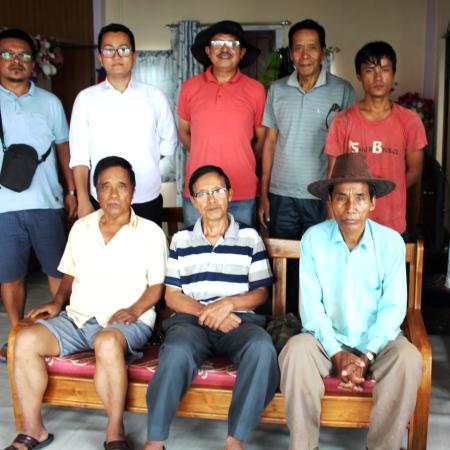
En la aldea de Khawrihnim, los agricultores practicaban el jhum desde hacía generaciones y en el campo jhum se practicaban cultivos secundarios, mixtos e intercalados de semillas oleaginosas, legumbres, hortalizas, especias y tubérculos junto con el arroz como cultivo principal.Aunque los agricultores eran conscientes de los beneficios del largo ciclo de barbecho y de la regeneración de los bosques, se mostraban escépticos ante la idea de continuar en la misma parcela jhum en el segundo año, ya que temían una drástica reducción del rendimiento de los cultivos debido a la pérdida de fertilidad del suelo. Además, el pueblo nunca había pensado en ello, ya que se sentían cómodos utilizando la tierra Jhum sólo durante un año, ya que tenían suficiente tierra a su disposición y actualmente su ciclo Jhum era de 9-10 años.
Las autoridades municipales y los agricultores quedaron convencidos tras el taller de que una pequeña modificación de su actual sistema de jum mediante medidas de optimización del jhum les beneficiaría enormemente al aumentar los ingresos familiares, al tiempo que se conservaba la biodiversidad y se mejoraban los servicios ecosistémicos de los usuarios de la tierra.


